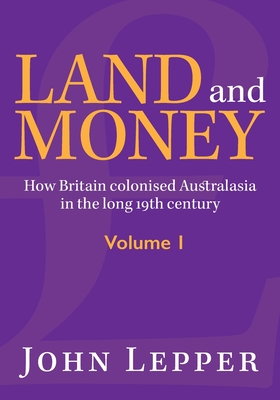Land and Money Volume 1: How Britain colonised Australasia in the long 19th century

Land and Money Volume 1: How Britain colonised Australasia in the long 19th century
1. Why Colonise Australasia?
2. Planting Non-Indigenous People, Enterprise and Society
3. Monetisation of Australasia
4. Marketable Land in Australasia
5. Start of an Australasian Banking Industry
6. Australasia and the Developing Gold Standard
7. New Zealand Land Market
Land issues bedevil all Australians and New Zealanders still. John Lepper followed the money trail back to European settlement. He starts with a question seldom asked: 'Why colonise Australasia?' Money, he found, was a big part of it, but philosophical currents, blood ties and defence policy are mooted too. In this, the first of two volumes that end in 1914, are how 'Our place' first got a monetary value. Enter the banks, a saga embracing the gold standard. A closing thought:
There were some differences between the situation in which Maori found themselves in [the 1840s] and that facing Australian Aboriginal Peoples. In NSW and Tasmania, the land the Aboriginal Peoples occupied could be freely granted by the crown without further ado ... Maori could sell their land at a price set by the Governor or not at all. The difference in outcome between the two native people was in practice very little ... a difference between terra nullius and terra next to nullius.
This economic (and other) history of two nations here breaks new ground in both. The link between land and money is not yet to be found in the textbooks.
PRP: 247.92 Lei
Acesta este Prețul Recomandat de Producător. Prețul de vânzare al produsului este afișat mai jos.
223.13Lei
223.13Lei
247.92 LeiLivrare in 2-4 saptamani
Descrierea produsului
1. Why Colonise Australasia?
2. Planting Non-Indigenous People, Enterprise and Society
3. Monetisation of Australasia
4. Marketable Land in Australasia
5. Start of an Australasian Banking Industry
6. Australasia and the Developing Gold Standard
7. New Zealand Land Market
Land issues bedevil all Australians and New Zealanders still. John Lepper followed the money trail back to European settlement. He starts with a question seldom asked: 'Why colonise Australasia?' Money, he found, was a big part of it, but philosophical currents, blood ties and defence policy are mooted too. In this, the first of two volumes that end in 1914, are how 'Our place' first got a monetary value. Enter the banks, a saga embracing the gold standard. A closing thought:
There were some differences between the situation in which Maori found themselves in [the 1840s] and that facing Australian Aboriginal Peoples. In NSW and Tasmania, the land the Aboriginal Peoples occupied could be freely granted by the crown without further ado ... Maori could sell their land at a price set by the Governor or not at all. The difference in outcome between the two native people was in practice very little ... a difference between terra nullius and terra next to nullius.
This economic (and other) history of two nations here breaks new ground in both. The link between land and money is not yet to be found in the textbooks.
Detaliile produsului









